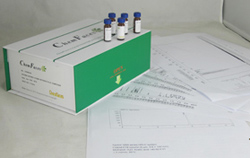Hot Products



| Catalog No. | Information |
| CFN80402 | Araloside VII Reference standards. |
| CFN90323 | Araloside X Aralosides possess protective effect against experimental myocardial ischemia and infarction, the mechanism of myocardial protection may be attributed to the amelioration of FFA metabolic deterioration and membrane peroxidation induced by oxygen free radicals. Aralosides have anti-inflammatory effect, they also can effectively prevent acute alcoholic liver injury. |
| CFN99550 | Arbutin Arbutin is a tyrosinase inhibitor with an IC50 of 1.09 mM, which has gastroprotective, whitening, anti- age, anti-oxidant , anti-inflammatory, a depigmenting effects and UVB/ UVC filter. Arbutin has mutagenicity in mammalian cells after activation by human intestinal bacteria. |
| CFN99534 | Arctigenin Arctigenin has anti-tumor, anti-inflammation, antioxidative , neuroprotection, and endurance enhancement effects; it efficiently enhances rat swimming endurance by elevation of the antioxidant capacity of the skeletal muscles, which has thereby highlighted the potential of this natural product as an antioxidant in the treatment of fatigue and related diseases. Arctigenin as a potent indirect activator of AMPK via inhibition of respiratory complex I, with beneficial effects on metabolic disorders in ob/ob mice, this highlights the potential value of arctigenin as a possible treatment of type 2 diabetes. |
| CFN90714 | Arctigenin 4'-O-beta-gentiobioside Arctigenin 4'-O-beta-gentiobioside is a natural product from Trachelospermum jasminoides. |
| CFN99991 | Arctiin Arctiin(NSC 315527), a plant lignan that can be extracted from the Arctium lappa (burdock) seeds, is a possible environmental endocrine disruptor compounds and have been shown to influence sex hormone metabolism as well as protein synthesis, steroid biosynthesis. Arctiin has been reported to have preventing obesity, antibacterial, antiviral, anti-inflammatory, and anti-oxidant effects in vitro. Arctiin inhibits adipogenesis in 3T3-L1 adipocytes through the inhibition of PPARγ and C/EBPα and the activation of AMPK signaling pathways. Arctiin also has a protective effect on ROS-induced cell dysfunction in HHDPCs and may therefore be useful for alopecia prevention and treatment strategies. |
| CFN99036 | Arctinol B Arctinol B has anti-oxidant activity. |
| CFN89251 | ar-Curcumene ar-Curcumene has antiinflammatory activity, it could be used as antiinflammatory drugs in respiratory infections. ar-Curcumene is effective as oviposition deterrents against Anopheles stephensi, Aedes aegypti, and Culex quinquefasciatus, it can be considered for the development of novel and effective mosquito larvicides. |
| CFN90177 | Ardisiacrispin A Ardisiacrispin A has cytotoxic activity toward HepG2 cancer cell with the GI(50) value of 1.56μM, it could inhibit the proliferation of Bel-7402 cells by inducing apoptosis and disassembling microtubule.Ardisiacrispin(A+B) exhibit prominent abilities to inhibit the proliferation of HL-60 cells by blocking the cell cycle at S phase and inducing apoptosis. |
| CFN91120 | Ardisiacrispin B Ardisiacrispin B displays cytotoxic effects in multi-factorial drug resistant cancer cells via ferroptotic and apoptotic cell death. |